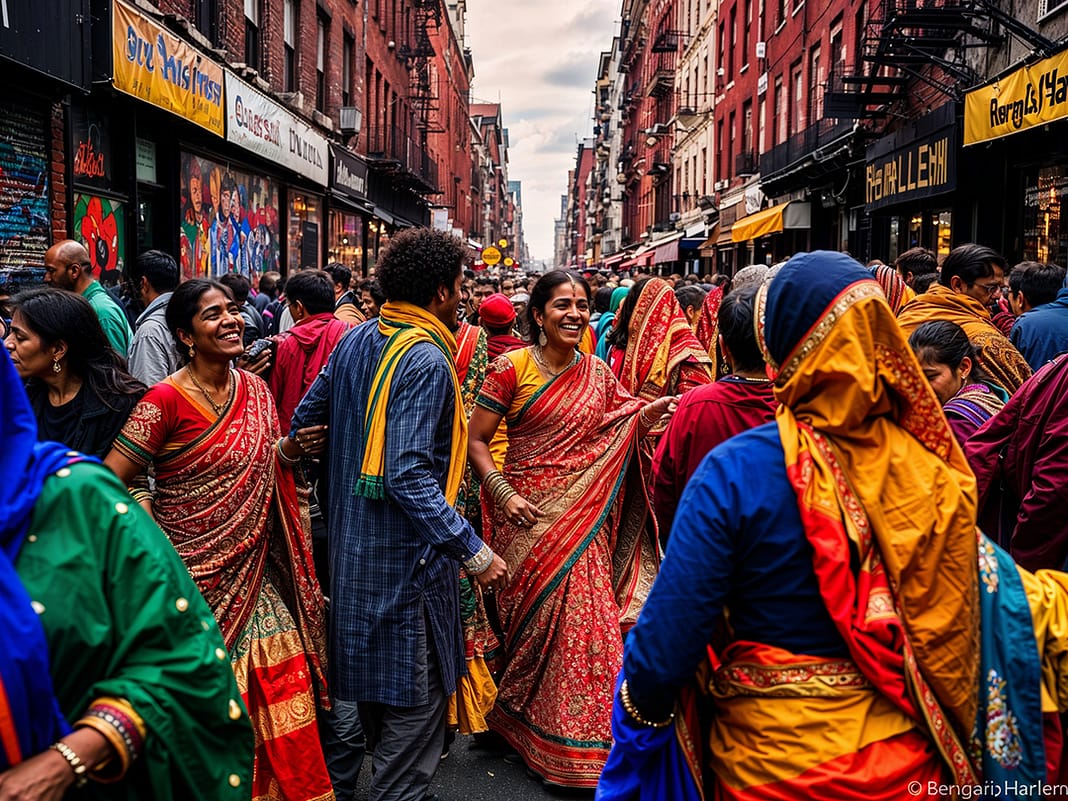There are stories that live on the margins of history, whispered in between the lines of what we think we know. They exist in the shadows of grander narratives, like breath held too long, waiting to be released. In Search of Bengali Harlem by Vivek Bald is the exhalation of one such story—a story of migration, race, and belonging that has been tucked away in the crevices of Harlem’s history for far too long. It is the story of Bengali Muslim immigrants who found themselves in the heart of a Black neighborhood, not by choice, but by necessity. They were seekers, men who crossed oceans in the early 1900s, chasing dreams that could not survive in the villages of British-occupied Bengal. They crossed into a new world that never promised them belonging, only the hope of survival. Vivek Bald has illuminated their journey in In Search of Bengali Harlem, bringing light to lives often left in the dark—lives that quietly shaped the city and their own fates in ways that history rarely records.
What makes this book so moving is the tenderness with which Bald approaches his subjects, the Bengali Muslim men who came to America not as professionals or students, but as sailors, peddlers, and laborers. These men, excluded from white society, found themselves in the alleyways and apartments of Harlem, side by side with African Americans and Puerto Ricans who shared their marginalization. The book’s heart lies in the way Bald uncovers how these men not only survived but built new lives by forming deep and unexpected connections across racial lines.
A History Uncovered
What strikes the reader immediately is the sheer audacity of the story Bald tells. The title itself—In Search of Bengali Harlem—suggests not just a history being uncovered, but a search for identity, belonging, and home in a landscape that is perpetually shifting. The men at the center of this narrative are not the typical immigrant success stories often romanticized in American history. Instead, they are men living on the edges of American society, where survival itself is a kind of victory.
Many of them came as part of the flow of South Asian seamen in the early 20th century, immigrants whose labor was seen but whose faces were often forgotten. They settled in Harlem, where they formed families with African American and Puerto Rican women, creating multicultural households that both challenged and enriched the racial dynamics of the time. These Bengali men did not arrive in America with wealth or connections; instead, they brought with them the weight of colonialism, poverty, and displacement, blending their struggles with those of the African American community they lived among. And Harlem, with its own history of migration and survival, became the backdrop for their quiet acts of resilience.
Bald meticulously weaves together archival records, census data, ship logs, and oral histories to reconstruct the lives of these men and their families. What emerges is a story not only of immigration but of intersectionality—where race, class, and identity collide in the most unexpected ways. The Bengali men who lived in Harlem occupied a liminal space, navigating a society that saw them as neither Black nor white, and in this liminality, they found connection with other marginalized people. This blending of worlds, of cultures, of identities, is what makes In Search of Bengali Harlem such a poignant exploration of what it means to live between borders.
Intersection of Cultures and Identities
The real beauty of Bald’s work lies in his exploration of identity. He doesn’t just tell us about the lives of Bengali men in Harlem; he tells us what it meant for them to create hybrid identities, born out of necessity and love. These Bengali immigrants, dark-skinned and foreign, found themselves racialized in a way that bound them to the struggles of Black Americans. Many of them married into African American and Puerto Rican families, creating children who inherited the complexity of their parents’ histories—children who straddled cultures, continents, and colors.
The questions we ask about race and belonging today were the same ones these families asked as they lived their lives in the cracks of Harlem’s streets. What does it mean to be a child of two worlds, where both are marginalized? How do you carry forward the traditions of your ancestors when your very existence is a blending of histories? These are the silent questions Bald allows to echo through his pages, never fully answered, because to live on the margins is to know that some questions have no neat resolution. Instead, we find that the answers lie in the lives lived, the families built, the meals shared.
Relevance and Resonance
One of the questions that frequently arises when readers engage with Bald’s work is, Why have we not heard of this history before? In an era where diversity and inclusion are at the forefront of our cultural consciousness, the story of Bengali Harlem reminds us that there are histories within histories, buried deep under the dominant narratives that have shaped our understanding of race in America. We talk about the Harlem Renaissance, the Great Migration, and the civil rights struggles of the 20th century, but rarely do we discuss the hidden lives of the immigrants who lived in the midst of these movements, contributing quietly to the very fabric of American life.
Another pressing question: What does this story teach us about the immigrant experience in America today? The story of Bengali Harlem is a reminder that migration is not just about crossing physical borders; it is about crossing the borders of identity, race, and culture. As we grapple with the realities of immigration in our current political climate, Bald’s work serves as a quiet call to remember the humanity of those who arrive on our shores seeking something better, even when the country offers little in return. It asks us to look beyond the statistics, beyond the headlines, and to see the people who are building lives in the spaces we often forget to look.
The Power of Forgotten Narratives
In Search of Bengali Harlem is not just a work of historical excavation; it is a work of compassion. Bald has created a space for these forgotten stories to breathe, to be remembered, and to be felt. As readers, we are reminded that history is not just what happens in the halls of power, but in the small, everyday acts of survival and love.
As we continue to unravel the threads of history, it is through works like In Search of Bengali Harlem that we begin to see the full picture—one that includes not just the loud and visible, but also the quiet, enduring lives of those who built our cities from the margins.
For those who feel moved by this forgotten history, there are other stories waiting to be discovered. Here are some recommendations that offer similarly rich explorations of identity, migration, and belonging:
- The Warmth of Other Suns by Isabel Wilkerson – A monumental account of the Great Migration, tracing the journeys of African Americans fleeing the Jim Crow South to cities like Harlem.
- The Fortune Men by Nadifa Mohamed – A powerful novel based on the real-life story of a Somali seaman wrongfully accused of murder in 1950s Britain, exploring themes of migration, race, and justice.
- Go Home! edited by Rowan Hisayo Buchanan – An anthology of essays and stories that explore the experiences of Asian diaspora communities, offering multiple perspectives on what it means to belong.
Discover more from The Reasoned Journey
Subscribe to get the latest posts sent to your email.


